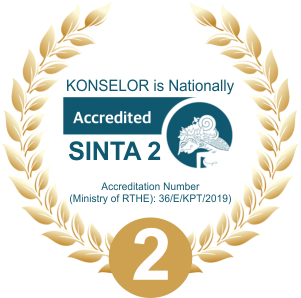Academic stress level guidance and counseling students at Universitas Negeri Padang
 ), Irna Andriani(2), Riska Ahmad(3),
), Irna Andriani(2), Riska Ahmad(3), (1) Universitas Negeri Padang
(2) Universitas Negeri Padang
(3) Universitas Negeri Padang
 Corresponding Author
Corresponding Author
Copyright (c) 2018 Neviyarni Neviyarni, Irna Andriani, Riska Ahmad
DOI : https://doi.org/10.24036/0201872100008-0-00
Full Text:
 Language : en
Language : en
Abstract
The phenomenon found in the field when students are given assignments, they will complain a lot. Counseling technique course I is a course that has many lectures.This article aims to describe academic stress level of students of Guidance and Counseling who are taking Counseling Technique Course I. It is seen from the emotional, intellectual, physical, and interpersonal symptoms. The study used a descriptive quantitative approach with the subject of 104 students. Data were collected using an academic stress scale. The results of the study reveal the level of academic stress of the students of the Guidance and Counseling Department who are taking the subjects of Counseling Technique I viewed from: (1) emotional symptoms (2) intellectual symptoms (3) physical symptoms, and (4) interpersonal symptoms are in the medium category. Of the 17 existing academic stress indicators, only one indicator is in the low category. The results of this study are important to provide input for students, lecturers in Counseling Technique I, and academic counselor in order to help reduce student academic stress level.
Keywords
References
Abraham, R. R., Zulkifli, E. M., Fan, E. S. Z., Xin, G. N. & Lim, J. T. G. (2009). A Report on Stress Among First Year Students in an Indian Medical School. South East Asian Journal of Medical Education. Vol. 3 (2):78-81.
Ali, B. S., Rahbar, M. H., Naeem, S., Tareen, A. L., Gui, A., & Samad, L., (2002). Prevalence of and Factors Associated with Anxiety and Depression Among Women in a Lower Middle Class Semi-Urban Community of Karachi, Pakistan. Journal of the Pakistan Medical Association. Vol. 52 (11):513–517.
Anggawijaya, S. (2013). Relationship of Depression with Academic Procrastination. Jurnal Ilmiah Mahasiswa Universitas Surabaya. Vol. 2 (2):1-12.
Bayram, N. & Bilgel, N. (2008). The Prevalence and Socio-Demographic Correlations of Depression, Anxiety and Stress Among a Group of University Students. Social Psychiatry and Psychiatric Epidemiology. Vol. 43 (8):667–672.
Dyrbye, L. N., Thomas, M. R., & Shanafelt, T. D., (2006). Systematic Review of Depression, Anxiety, and Other Indicators of Psychological Distress Among U.S. and Canadian Medical Students. Academic Medicine. Vol. 81 (4):354–373.
Eisenberg, D., Golberstein, E., Gollust, S., & Hefner, J. (2007). Prevalence and Correlates of Depression, Anxiety and Suicidality Among University Students. AmericanJournal of Orthopsychiatry. Vol. 77 (4):534–542.
Gunawati, R., Hartati, S., Listiara, A. (2006). Relationship between Communication Effectiveness of Thesis Supervisors with Stress in Developing Thesis on Student of Psychology Study Program of Diponegoro University Medical Faculty. Journal of Psychology Diponegoro University, Vol. 3 (2):94-115.
Misra, R., Crist, M., & Burant, C. J. (2003). Relationships Among Life Stress, Social Support, Academic Stressors, and Reactions to Stressors of International Students in the United States. Journal of Stress Management. Vol. 10 (2):137-157.
Mori, S. C. (2000). Addressing the Mental Health Concerns of International Students. Journal of Counseling and Development. Vol. 78 (2):137–144.
Nasehudin, T. S. (2012). Quantitative Research Methods. Bandung: Faithful Library.
Nevid, J. S., Rathus, S. A., & Greene, B. (2005). Abnormal psychology. Jakarta: Erlangga.
Nurmaliyah, F. (2014). Reduce Student's Student's Stress by Using Self-Instruction Technique. Journal of Humanities Education. Vol. 2 (3):273-282.
Patimah, S. (2016). Stress Management Perspective of Islamic Education. Bandung: Alfabeta.
Pinurbawati, N. H. (2011). Student Academic Stress Viewed from Attitude to Burden of Duty. Thesis (Unpublished). Faculty of Psychology Catholic University Soegijapranata Semarang.
Purwanto, N. A. (2009). Creativity of Educational Leaders in Decision Making. Journal of Management Education. No. 1:25-35.
Raharso, S. (2011). Trust in the team. Journal of Managerial Politeknik Negeri Bandung. Vol. 10 (19):42-53.
Rohmah, F. A. (2006). The Influence of Group Discussion to Reduce Stress on High Students Thesis. Indonesian Psychological Journal. Vol. 3 (1):50-62.
Sarwono, S. W. (2009). Introduction to General Psychology. Jakarta: Rajawali Pers.
Shamsuddin, K., Fadzil, F., Ismail, W. S. W., Shah, S. A., Omar, K., Muhammad, N. A., Jaffar, A., Ismail, A., & Mahadevan, R. (2013). Correlates of Depression, Anxiety and Stress Among Malaysian University Students. Asian Journal of Psychiatry. Vol.6 (4):318-323.
Stewart-Brown, S., Evans, J., Patterson, J., Petersen, S., Doll, H., Balding, J., & Regis, D. (2000). The Health of Students in Institutes of Higher Education: an Important Public Health Problem? Journal of Public Health Medicine . Vol. 22 (4):492–499.
Struthers, C. W., Perry, R. P. & Menec, V. H. (2000). An Examination of the Relationship Among Academic Stress, Coping, Motivation, and Performance in College. Journal Higher Education. Vol. 41 (5):581-592.
Taufik, T., Ifdil, I.,&Ardi, Z. (2013). Kondisi Stres Akademik Siswa SMA Negeridi Kota Padang, Jurnal Konseling dan Pendidikan, Vol. 1 (2):143–150.
Thurson, H. (2005). Learning Effectively. Jakarta: Private Puspa.
Yusuf, S. (2008). Mental Hygiene. Bandung: Maestro.
 Article Metrics
Article Metrics
 Abstract Views : 966 times
Abstract Views : 966 times
 PDF Downloaded : 264 times
PDF Downloaded : 264 times
Refbacks
- There are currently no refbacks.
Copyright (c) 2018 Neviyarni Neviyarni, Irna Andriani, Riska Ahmad

This work is licensed under a Creative Commons Attribution 4.0 International License.







